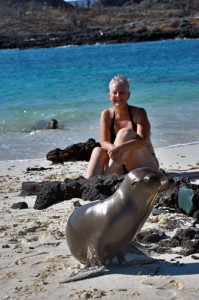I have always felt an affinity with wild animals and they, likewise, seem inordinately attracted to me. On a visit to the Adirondack Mountains of upstate New York this summer, a black racer snake crawled across my foot. On safari in the Serengeti of Africa we encountered a lion sleeping with his head hidden behind a rock. I politely asked him to sit up for a photo. My guide’s snigger turned to amazement when the lion sat up regally and looked directly at me. After snapping a few photos I thanked the huge male and he laid back down.
Of all my wildlife encounters around the world, none have been more astounding than those with sea lions in the Galapagos Islands of Ecuador. Sea lions have a reputation as curious animals who often investigate divers. Last year in Mexico a family of sea lions checked me out from a respectful distance as I snorkeled in the cold blue waters off the coast of La Paz, Mexico. But in the Galapagos, these sleek brown animals collected by the hundreds on beaches and lay across trails, completely indifferent to humans. On land it was usually not a problem to maintain the six foot distance required between man and animal, though at times our diversions took us through boulder fields and prickly vegetation. In the water, however, it was another story.
One day my sister and I snorkeled around a point and swam into a cove surrounded by submerged rocks where a lone sea lion frolicked. He torpedoed back and forth and swam circles around us, inching ever closer. We twisted and turned, trying to keep him in view, but he was just too fast for us. I popped to the surface and yelled for the rest of our group to join us. Instead of being threatened by our larger numbers, the sea lion seemed energized. Time and again he broke the surface for air and nose-dived to the bottom. Playfully, he began exhaling as he raced around us, encasing us in a cylinder of bubbles that began as giant oval pockets and broke into a million swirling, iridescent pinpoints that slowly rose to the surface. Though I don’t have an underwater camera, one of my fellow writers did and he very graciously allowed me to show the above video.
Later that week, rather than snorkel or kayak, I opted for a trip to a gorgeous white sand beach on Chinese Hat. After a swim in the crystalline turquoise waters I settled down on my towel and was soon fast asleep. A shout from our naturalist, Ceci Guerrero, woke me up. “Bobbie, get up. Don’t touch, just look.” (with three Barbaras on the trip, I had been dubbed Bobbie). Two young female sea lions were waddling up the sand toward me. Curious, one of them touched my thigh with its nose while the other went around my back side. I turned to follow the antics of the one at my rear, unaware of what was happening at the shore, until Guerrero yelled again. “Watch out Bobbie! Look behind you.” A giant bull had chased away a young male and herded these two young females onto the beach, intending to add them to his harem. Sensing that I was a new threat, he rose from the ocean and headed toward me. The ensuing series of photos taken by Ceci show what happened better than I can put into words.
Throughout the eight days of our cruise, sea lions were the most precocious, delightful animals of all the species we encountered. They are so cute that I yearned to reach out and touch one, but of course that is prohibited. I asked our other naturalist, Yvonne Mortola, if she’d ever felt their fur. “Only a dead one, ” she replied. As much as she would like to stroke a live sea lion, she believes doing so would be the beginning of the end.
Despite the fact that Mortola can’t touch the animals in the Galapagos, she has a unique relationship with them. One day I thought she asked me to turn around so she could take my picture. When I complied she laughed, “I was talking to the lava lizard.” The lizard willingly turned around on its rock and posed for a photo. I was delighted to learn that I am not the only crazy person who thinks she can communicate with animals.
Barbara Weibel
24 Oct 2011
http://holeinthedonut.com/2011/10/24/galapagos-islands-ecuador-sea-lions/
